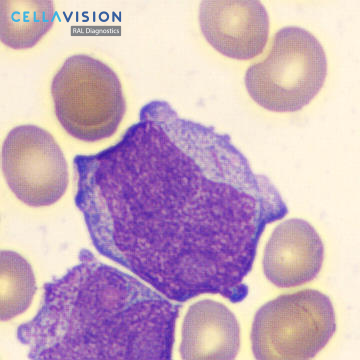This is a monoblast, found in certain subtypes of Acute Myeloid Leukemia. Let us tell you more about Acute Myeloid Leukemia.

Definition
Acute myeloid leukemia (AML) is a type of cancer that affects the blood and bone marrow. In AML, immature white blood cells multiply rapidly and accumulate in the bone marrow, disrupting routine blood cell production. As a result, there is a shortage of normal blood cells, including red blood cells, platelets, and mature white blood cells, which can lead to anemia, bleeding, and infections. AMLs are classified based on morphology, immunophenotype, genetic, and clinical parameters. The severity of the disease and/or specific treatment can differ between AML subtypes.
Incidence rate
AML can occur at any age but is generally a disease of older people. The average age at diagnosis is around 65.
Cause
The origin of AML is often unknown. Epidemiological studies highlighted that some environmental factors like ionizing radiation and benzene exposure are linked to acute leukemia. Chemotherapies against other cancers are also one of the causes of AML.
Symptoms
The symptoms of AML can vary, but they generally include fatigue, weakness, shortness of breath, fever, recurrent infections, bruising or bleeding easily, bone pain, and weight loss.
Diagnosis
Diagnosis of AML typically involves a physical exam, blood tests, and bone marrow biopsy. A complete blood count (CBC) is a key blood test to show unusual increases or decreases in cell counts.
If a problem is detected, microscopic examination of a Wright-Giemsa, MGG, or MCDhTM stained blood film is used to differentiate between populations of blood cells based on their size, shape, color, and other features. Normal blood cells have distinct characteristics that allow them to be identified microscopically. Cancer cells in AML, on the other hand, may have abnormalities in their shape, size, color etc., which are used in their identification. In the case of AML, a blood film will often confirm an abnormal presence and number of monocyte precursors, immature granulocytes, myeloblasts, and/or other types of blasts. These cells have a larger, more immature nucleus than normal blood cells, and their cytoplasm may contain abnormal granulation. Due to a high proliferation rate, the leukemic cells may outnumber normal blood cells in the sample.
Following the microscopic examination of blood, specific tests, such as peroxidase activity, immunophenotyping, karyotyping, and molecular genetics will diagnose the specific subtype of AML and determine the appropriate treatment.
Treatment
Treatment of AML depends on the patient's age, overall health, and the AML subtype. The primary goal of treatment is to destroy the cancerous cells and allow normal blood cell production to resume. The most common treatment options include chemotherapy, radiation therapy, stem cell transplant, or a combination. In some cases, targeted therapies or immunotherapy may also be used.
News
Ongoing scientific research allows us to improve AML patient care, notably with a periodic review of the classification of AML and adjusting it based on this research. In 2022, the WHO updated the classification of hematologic neoplasia and emphasized the correlation of cell morphology and genetic parameters to help identify specific types of AML.
See you next month for another Quiz 🎲!